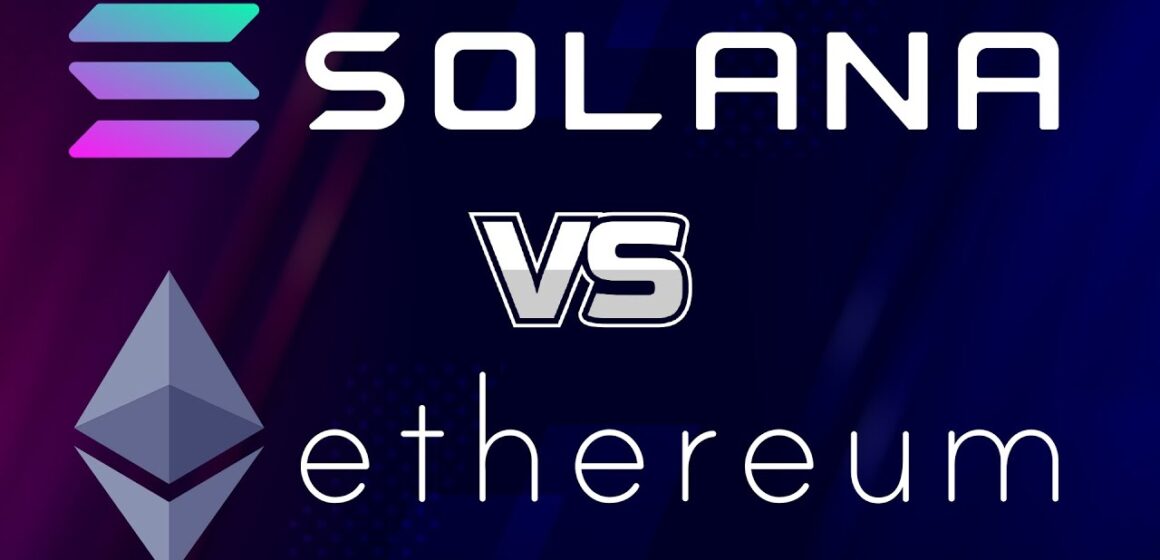In the cryptocurrency space, there is a lot of debate about which blockchain platform is best suited to building non-fungible tokens (NFTs).
These questions are important to those who want to create NFTs, as well as those who want to use them. In this article, we’ll compare Ethereum and Solana on a number of different metrics with an eye toward answering these questions.
About Blockchain Ethereum
Ethereum is a decentralized platform that runs smart contracts: applications that run exactly as programmed without any possibility of downtime, censorship, fraud or third party interference.
It can be used to codify, decentralize, secure and trade just about anything: voting, domain names, financial exchanges and much more.
Ethereum can be thought of as a “world computer” that offers a global virtual machine powered by its own cryptocurrency called Ether.
About Blockchain Solana
If you’ve been following the blockchain space, you may have heard of Solana. Solana is a new blockchain platform designed to be highly scalable, fast and secure.
It was created by some of the same people who created Ethereum, and it aims to be a solution for building highly scalable Dapps in the future.
Solana was originally announced back in 2017 and has since raised $6 million from investors like Andreessen Horowitz and Polychain Capital.
The project is still under development at this point but we did some research into what it might look like when it’s finally ready for prime time use cases like non-fungible tokens (NFTs).
Which is better in building NFTs? Ethereum or Solana?
You may be wondering, which is better in building NFTs? Ethereum or Solana?
Ethereum is the most popular blockchain for building NFTs. It has a large community, experienced developers and tons of infrastructure available.
However, it has some drawbacks: its performance is not as good as Solana (it takes Ethereum about 10 seconds to process 1 transaction).
Solana was released in October 2019 with a goal of solving some of these problems by using sharding technology and having faster-than-light consensus protocol.
And indeed, according to their website & Twitter feed they have managed to achieve 20x more transactions per second than Ethereum.
So if you’re looking for low latency / high throughput then Solana might be your best bet when choosing an ecosystem that supports non-fungible tokens issuance on top of existing blockchains such as ERC721 standard tokenization methodologies through smart contracts etc.
Ethereum vs Solana NFT: Costs
The cost to create an NFT is different for both Ethereum and Solana.
On the Ethereum blockchain, you have to pay gas fees to deploy a smart contract that manages your NFT ownership. The amount of gas fees will depend on how complex the contract is and how much storage it requires.
Gas prices are determined by market demand, so if there are a lot of people trying to use the Ethereum network at one time, then it will become more expensive for everyone else who wants to make transactions with their crypto assets.
On Solana’s side of things, there are no transaction fees associated with creating or transferring non-fungible tokens (NFTs).
However, since they use proof-of-stake consensus rather than proof-of-work (PoW), they don’t actually require miners like most cryptocurrencies need when processing transactions.
In order for them to be confirmed quickly enough without waiting hours or even days, before being added into blocks by computers around the world working together as part of large pools called mining farms which can mine faster than any individual computer could ever do on its own
Cost to Create NFTs on Ethereum
When you create a non-fungible token on Ethereum, you need to pay the transaction fee. The amount of this fee varies depending on the type of transaction and its size.
If you are creating a standard ERC-721 token with no special features, then it will cost about $0.25 in fees for each new contract created by your smart contract code.
However, if you want to add some special features like voting or dividends, then there is an additional gas fee that must be paid as well.
The Solana price gas fee varies based on what kind of feature is being requested by the user and whether or not they are staking their tokens before requesting said feature.
Cost to Create NFTs on Solana
Ethereum’s NFT creation cost is approximately 1.5 cents per token, while Solana’s is just 0.75 cents per NFT created on its blockchain.
This difference in cost makes it far more economical to create an NFT on Solana than Ethereum and also helps to promote the growth of this technology by making it easier for people to create and use these unique digital assets.
Ethereum vs Solana NFT: User Friendliness
Ethereum is more user-friendly. This shouldn’t be surprising, given that it has been around longer than Solana and has a larger community of users and developers. In addition to this, there are more tools for developers to use on Ethereum compared to Solana.
Solana doesn’t have a clear roadmap for how long it will take them to launch the mainnet (the final version of their network) or when they will release plans for scaling up performance or making changes that would improve scalability and throughput (the number of transactions per second).
Conclusion
In a nutshell, the choice between Ethereum and Solana is a matter of preference. If you want to build an NFT on a blockchain that has the most users and most developer support, then Ethereum is probably your best bet.
On the other hand, if you want speed and scalability at any cost (even if it means sacrificing some user friendliness), then Solana might be right for you.

